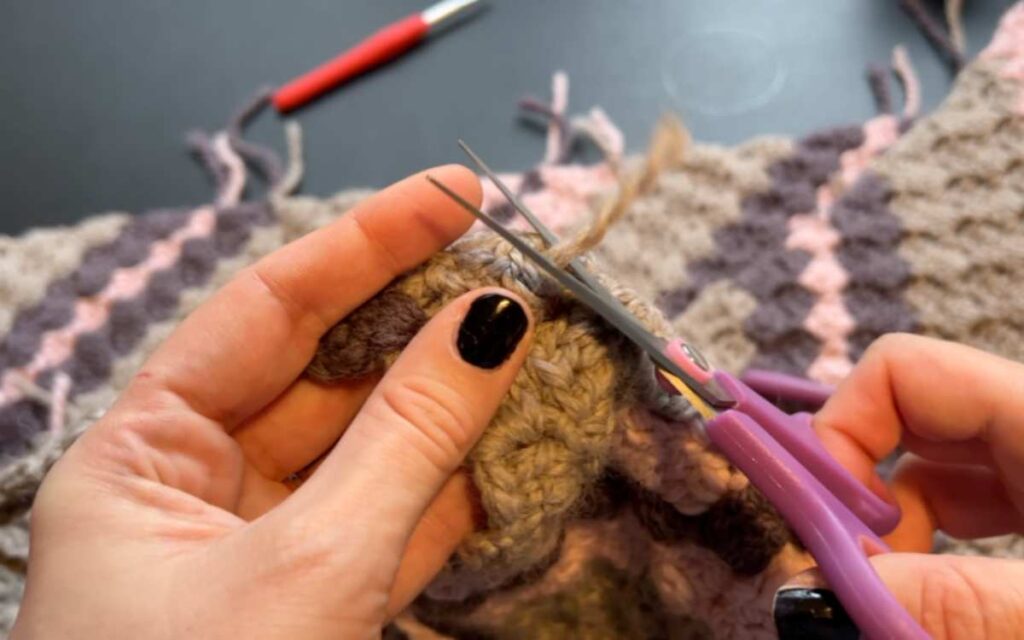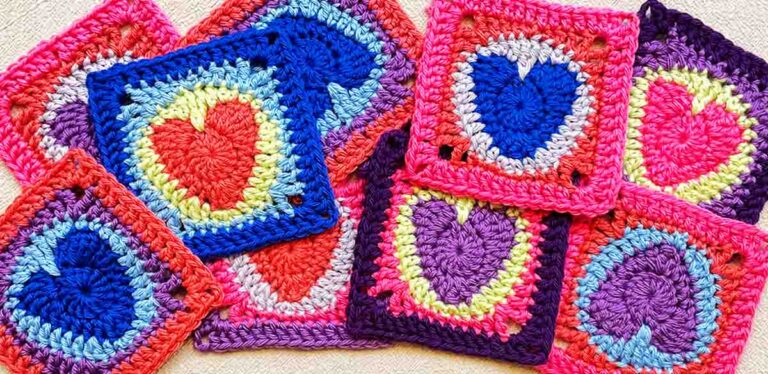Sewing, Crocheting and Hooking In Your Loose Ends

Loose ends are the bane of the crocheter’s existence. You feel like you’ve finished this huge crocheted work of art, sit back, and dozens of long yarn strands waggle in the air, laughing at you. Items I crocheted a decade ago still taunt me today with their dangling ends, but thankfully as I have learned and gained experience over the years, my more recent projects no longer have these issues.
I use three different methods to hide loose ends in my crochet now. Those at the edge of the blanket I often hide within a border, and those in the central parts I either weave in with a needle, or tease through the existing stitches with a crochet hook.
There is no perfect method, there are pros and cons to all three of these. But I do have a favorite!
I recommend leaving your yarn tail long enough that you can work it through at least a dozen stitches. This not only makes it easier to disguise the loose end, but means if the crochet stitches are damaged or unravelled in the future you’ll have more yarn to work with on the repair.
Hiding Loose Ends In A Crochet Border

If your loose ends are at the edge of your crocheter garment then adding a border can be the easiest way to hide them. Especially if there are an awful lot from repeated color changes.
To hide your loose ends within a border simply let the end lay other the stitch that you are working into.
Hook through the stitch, check the end is laying over that stitch, yarn over the hook and pull through. Yarn over hook again, making sure the loose end is still in place, and pull through the loops on the crochet hook.
The main benefit of this method is it is fast, and often you were going to crochet a border anyway so you aren’t putting any extra effort in at all.
The downside is that it really only helps if your loose ends are hanging out at the borders.
Weaving In Loose Ends With A Yarn Needle

When I’ve got long tails of yarn to hide within the body of my work, this is my preferred method for hiding them.
Pick up your loose end in your non-dominant hand and rub the point it was cut a few times between your fingers to bring it to a point. Insert the end through the eye of your needle.
Make sure you pull a fair chunk of yarn through your needle’s eye, otherwise it’ll fall out when you start sewing.
Color matching where possible, insert your needle into the nearest stitch. Line it up with the center of the stitch, so that there is yarn to either side. This will help to hide it in the body of your work.
Push the needle through at least a dozen stitches if possible, and then neatly snip the end with a yarn cutter or scissors. Line your cut point up with the edge of a stitch, but be very careful not to clip the yarn of the stitch itself.

This method is the best for amigurumi loose ends or for hiding loose ends within a blanket with tight stitches like single crochets.
The downside is threading each strand of the yarn onto the needle takes time, and if you aren’t a sewing fan it’s a frustrating fine motor movement you could do without.
Hooking Your Loose Ends Into The Fabric

Hooking your loose ends into your crochet is in many ways the most obvious way to deal with a problem. After all, you already have a hook on your if you’ve just finished making something. But for me, the best way to hook loose ends in is to pick up a smaller size.
In the example I’ve shown on this article I made the corner to corner blanket with a 6mm crochet hook, and the hook I used to hide some of the stitches was 4mm. So a whole third smaller in size.
When I hook yarn into my work I can only do about four stitches at once maximum, so it’s a bit slower than the needle. But you don’t have to spend time threading it, you just hook through the stitches, pick up your tail, and pull it through.
The main benefit of this is that all crocheters have hooks, so you’re not grovelling around looking for a needle. You also don’t need to work with a different tool to your used to, or to fiddle about getting chunky yarn through an unreasonably small eye.
The downside is that you will find it harder to push a hook through your stitches, and you can run it through fewer stitches in one go than you can with a needle.
Needles For Me!
In most cases, my favorite way to hide loose crochet ends is with a needle. I’m comfortable using this tool, have them in a variety of sizes and don’t mind spending some time weaving in and out after my blanket is complete.
But the other methods are fine too, and it really is largely down to personal preference.
What do you think? Let me know in the comments or hit me up on socials with your response.
Happy Crocheting,
Lucy Kate, x






Hi! Thanks for the notes and great ideas. I love the pattern of your example. I’ve tried something similar but do you have a tutorial or beginner -ish friendly pattern that is for what you made or know the stitch name? Thanks a ton
Hi Jen, The example pattern is a corner to corner crochet blanket. I’m about half way through writing it up, I will link to the pattern when it is done. In the meantime I’d search for simple corner to corner crochet blanket patterns on Google and hopefully you’ll find something you like 🙂 Have fun! Lucy Kate, x